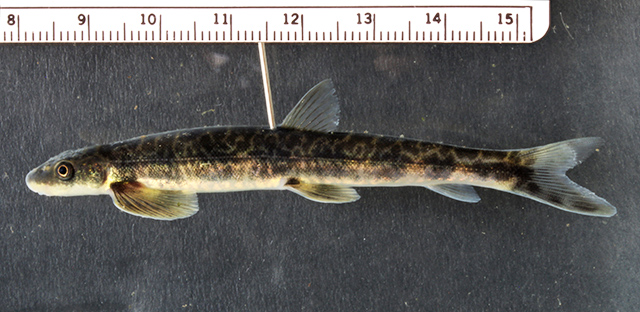|
Dorsal spines (total): 0; Dorsal soft rays (total): 9-11; Anal spines: -0; Anal soft rays: 8-9; Vertebrae: 37-38. Diagnosis: body depth 6.65-7.2 times in SL (Ref. 89136), 11.9-15.5% SL, with greatest depth at or slightly anterior to dorsal fin (Ref. 81636). Head length 4.1-4.8 times in SL (Ref. 89134, 89136), 17.9-22.7% SL (Ref. 81636). Snout length 2.65-3 times in HL (Ref. 89136). Eye dorsolateral (Ref. 81636, 89136), 3.85-4.8 times in HL, 1.4-1.8 times in snout length (Ref. 89134, 89136), 1.1-1.5 times in interorbital distance (Ref. 89136). Interorbital distance wide, 27.8-43.4% HL (Ref. 81636). Dorsal fin origin 1.15-1.2 times further from snout tip than from caudal fin origin; anal fin origin 1.85-2.15 times further from pelvic fin origin than from caudal fin origin (Ref. 89136). Pectoral fin enlarged and paddle-shaped (Ref. 81636), 4.5-5.1 times in SL (Ref. 89134, 89136), 0.9-0.95 times longer than head (Ref. 89136). Pelvic fin 6.2-7 times in SL, 1.35-1.5 times in HL (Ref. 89136). Both pectoral and pelvic fins fan out from body in the horizontal plane formed by the ventral surface (Ref. 81636). Caudal peduncle 1.4-1.7 times longer than deep (Ref. 89134, 89136).
Description: ventral profile flat (Ref. 81636). Mouth inferior (Ref. 81636, 89136) and straight, running most of the width of the head (Ref. 81636). Both jaws with continuous keratinized ridge instead of teeth; upper lip forms a small, fleshy lappet on both sides of the mouth (Ref. 81636). Lower lip absent, but cutting edge present (Ref. 89136). Gill opening short, formed by a skin flap extending from opercle posteriorly beyond pectoral fin base; epibranchial organ present (Ref. 81636). Caudal fin with 18-19 soft rays (Ref. 81636, 89136) including an unbranched ray at both the dorsal and ventral edge (Ref. 81636), forked, lobes more or less pointed (Ref. 80297), lower lobe a little longer than upper (Ref. 89136). Scales small, cycloid; 3 branchiostegal rays (Ref. 81636).
Coloration: preserved specimens: base body coloration yellowish brown between dark blotches; head, flanks and dorsum entirely covered with dark brown blotches separated by very narrow, yellowish borders (Ref. 81636). Along flanks, dark blotches coalesce to form a row of 5-9 large, dark spots (Ref. 81636, 89136). Dark pigment present along rays of all fins, faintest in anal fin; caudal fin with 4 dark spots on each lobe, forming continuous bands anterior to fork (Ref. 81636). Dorsal, pectoral and caudal fins sometimes with brownish spots (Ref. 80297). Dark spots at pelvic fin base (Ref. 80297, 81636) and caudal fin base (Ref. 81636). Ventral surface yellowish brown (Ref. 81636). Infralateral spots more or less visible (Ref. 89136). |
